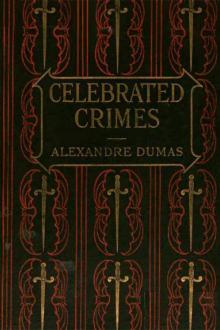The Complete Celebrated Crimes, Alexandre Dumas [good romance books to read TXT] 📗

- Author: Alexandre Dumas
- Performer: -
Book online «The Complete Celebrated Crimes, Alexandre Dumas [good romance books to read TXT] 📗». Author Alexandre Dumas
“In 1698 M. de Saint-Mars was promoted from the governorship of the Iles Sainte-Marguerite to that of the Bastille. In moving thither, accompanied by his prisoner, he made his estate of Palteau a halting-place. The masked man arrived in a litter which preceded that of M. de Saint-Mars, and several mounted men rode beside it. The peasants were assembled to greet their liege lord. M. de Saint-Mars dined with his prisoner, who sat with his back to the diningroom windows, which looked out on the court. None of the peasants whom I have questioned were able to see whether the man kept his mask on while eating, but they all noticed that M. de Saint-Mars, who sat opposite to his charge, laid two pistols beside his plate; that only one footman waited at table, who went into the antechamber to change the plates and dishes, always carefully closing the diningroom door behind him. When the prisoner crossed the courtyard his face was covered with a black mask, but the peasants could see his lips and teeth, and remarked that he was tall, and had white hair. M. de Saint-Mars slept in a bed placed beside the prisoner’s. M. de Blainvilliers told me also that ‘as soon as he was dead, which happened in 1704, he was buried at Saint-Paul’s,’ and that ‘the coffin was filled with substances which would rapidly consume the body.’ He added, ‘I never heard that the masked man spoke with an English accent.’”
Sainte-Foix proved the story related by M. de Blainvilliers to be little worthy of belief, showing by a circumstance mentioned in the letter that the imprisoned man could not be the Duc de Beaufort; witness the epigram of Madame de Choisy, “M. de Beaufort longs to bite and can’t,” whereas the peasants had seen the prisoner’s teeth through his mask. It appeared as if the theory of Sainte-Foix were going to stand, when a Jesuit father, named Griffet, who was confessor at the Bastille, devoted chapter xiii, of his ‘Traite des differentes Sortes de Preuves qui servent a etablir la Verite dans l’Histoire’ (12mo, Liege, 1769) to the consideration of the Iron Mask. He was the first to quote an authentic document which certifies that the Man in the Iron Mask about whom there was so much disputing really existed. This was the written journal of M. du Jonca, King’s Lieutenant in the Bastille in 1698, from which Pere Griffet took the following passage:—
“On Thursday, September the 8th, 1698, at three o’clock in the afternoon, M. de Saint-Mars, the new governor of the Bastille, entered upon his duties. He arrived from the islands of Sainte-Marguerite, bringing with him in a litter a prisoner whose name is a secret, and whom he had had under his charge there, and at Pignerol. This prisoner, who was always masked, was at first placed in the Bassiniere tower, where he remained until the evening. At nine o’clock p.m. I took him to the third room of the Bertaudiere tower, which I had had already furnished before his arrival with all needful articles, having received orders to do so from M. de Saint-Mars. While I was showing him the way to his room, I was accompanied by M. Rosarges, who had also arrived along with M. de Saint-Mars, and whose office it was to wait on the said prisoner, whose table is to be supplied by the governor.”
Du Jonca’s diary records the death of the prisoner in the following terms:—
“Monday, 19th November 1703. The unknown prisoner, who always wore a black velvet mask, and whom M. de Saint-Mars brought with him from the Iles Sainte-Marguerite, and whom he had so long in charge, felt slightly unwell yesterday on coming back from mass. He died to-day at 10 p.m. without having a serious illness, indeed it could not have been slighter. M. Guiraut, our chaplain, confessed him yesterday, but as his death was quite unexpected he did not receive the last sacraments, although the chaplain was able to exhort him up to the moment of his death. He was buried on Tuesday the 20th November at 4 P.M. in the burial-ground of St. Paul’s, our parish church. The funeral expenses amounted to 40 livres.”
His name and age were withheld from the priests of the parish. The entry made in the parish register, which Pere Griffet also gives, is in the following words:—
“On the 19th November 1703, Marchiali, aged about forty-five, died in the Bastille, whose body was buried in the graveyard of Saint-Paul’s, his parish, on the 20th instant, in the presence of M. Rosarges and of M. Reilh, Surgeon-Major of the Bastille.
“(Signed) ROSARGES. “REILH.”
As soon as he was dead everything belonging to him, without exception, was burned; such as his linen, clothes, bed and bedding, rugs, chairs, and even the doors of the room he occupied. His service of plate was melted down, the walls of his room were scoured and whitewashed, the very floor was renewed, from fear of his having hidden a note under it, or left some mark by which he could be recognised.
Pere Griffet did not agree with the opinions of either Lagrange-Chancel or Sainte-Foix, but seemed to incline towards the theory set forth in the ‘Memoires de Perse’, against which no irrefutable objections had been advanced. He concluded by saying that before arriving at any decision as to who the prisoner really was, it would be necessary to ascertain the exact date of his arrival at Pignerol.
Sainte-Foix hastened to reply, upholding the soundness of the views he had advanced. He procured from Arras a copy of an entry in the registers of the Cathedral Chapter, stating that Louis XIV had written with his own hand to the said Chapter that they were to admit to burial the body of the Comte de Vermandois, who had died in the city of Courtrai; that he desired that the deceased should be interred in the centre of the choir, in the vault in which lay the remains of Elisabeth, Comtesse de Vermandois, wife of Philip of Alsace, Comte de Flanders, who had died in 1182. It is not to be supposed that Louis XIV would have chosen a family vault in which to bury a log of wood.
Sainte-Foix was, however, not acquainted with the letter of Barbezieux, dated the 13th August 1691, to which we have already referred, as a proof that the prisoner was not the Comte de Vermandois; it is equally a proof that he was not the Duke of Monmouth, as Sainte-Foix maintained; for sentence was passed on the Duke of Monmouth in 1685, so that it could not be of him either that Barbezieux wrote in 1691, “The prisoner whom you have had in charge for twenty years.”
In the very year in which Sainte-Foix began to flatter himself that his theory was successfully established, Baron Heiss brought a new one forward, in a letter dated “Phalsburg, 28th June 1770,” and addressed to the ‘Journal Enclycopedique’. It was accompanied by a letter translated from the Italian which appeared in the ‘Histoire Abregee de l’Europe’ by Jacques Bernard, published by Claude Jordan, Leyden, 1685-87, in detached sheets. This letter stated (August 1687, article ‘Mantoue’) that the Duke of Mantua being desirous to sell his capital, Casale, to the King of France, had been dissuaded therefrom by his secretary, and induced to join the other princes of Italy in their endeavours to thwart the ambitious schemes of Louis XVI. The Marquis d’Arcy, French ambassador to the court of Savoy, having been informed of the secretary’s influence, distinguished him by all kinds of civilities, asked him frequently to table, and at last invited him to join a large hunting party two or three leagues outside Turin. They set out together, but at a short distance from the city were surrounded by a dozen horsemen, who carried off the secretary, ‘disguised him, put a mask on him, and took him to Pignerol.’ He was not kept long in this fortress, as it was ‘too near the Italian frontier, and although he was carefully guarded it was feared that the walls would speak’; so he was transferred to the Iles Sainte-Marguerite, where he is at present in the custody of M. de Saint-Mars.
This theory, of which much was heard later, did not at first excite much attention. What is certain is that the Duke of Mantua’s secretary, by name Matthioli, was arrested in 1679 through the agency of Abbe d’Estrade and M. de Catinat, and taken with the utmost secrecy to Pignerol, where he was imprisoned and placed in charge of M. de Saint-Mars. He must not, however, be confounded with the Man in the Iron Mask.
Catinat says of Matthioli in a letter to Louvois “No one knows the name of this knave.”
Louvois writes to Saint-Mars: “I admire your patience in waiting for an order to treat such a rogue as he deserves, when he treats you with disrespect.”
Saint-Mars replies to the minister: “I have charged Blainvilliers to show him a cudgel and tell him that with its aid we can make the froward meek.”
Again Louvois writes: “The clothes of such people must be made to last three or four years.”
This cannot have been the nameless prisoner who was treated with such consideration, before whom Louvois stood bareheaded, who was supplied with fine linen and lace, and so on.
Altogether, we gather from the correspondence of Saint-Mars that the unhappy man alluded to above was confined along with a mad Jacobin, and at last became mad himself, and succumbed to his misery in 1686.
Voltaire, who was probably the first to supply such inexhaustible food for controversy, kept silence and took no part in the discussions. But when all the theories had been presented to the public, he set about refuting them. He made himself very merry, in the seventh edition of ‘Questions sur l’Encyclopedie distibuees en forme de Dictionnaire (Geneva, 1791), over the complaisance attributed to Louis XIV in acting as police-sergeant and gaoler for James II, William III, and Anne, with all of whom he was at war. Persisting still in taking 1661 or 1662 as the date when the incarceration of the masked prisoner began, he attacks the opinions advanced by Lagrange-Chancel and Pere Griffet, which they had drawn from the anonymous ‘Memoires secrets pour servir a l’Histoire de Perse’. “Having thus dissipated all these illusions,” he says, “let us now consider who the masked prisoner was, and how old he was when he died. It is evident that if he was never allowed to walk in the courtyard of the Bastille or to see a physician without his mask, it must have been lest his too striking resemblance to someone should be remarked; he could show his tongue but not his face. As regards his age, he himself told the apothecary at the Bastille, a few days before his death, that he thought he was about sixty; this I have often heard from a son-in-law to this apothecary, M. Marsoban, surgeon to Marshal Richelieu, and afterwards to the regent, the Duc d’Orleans. The writer





Comments (0)